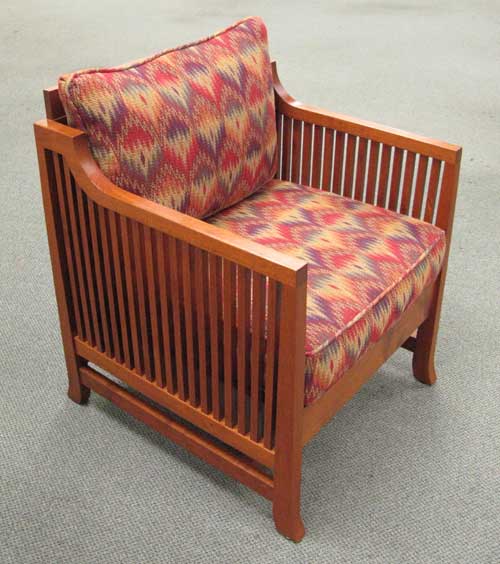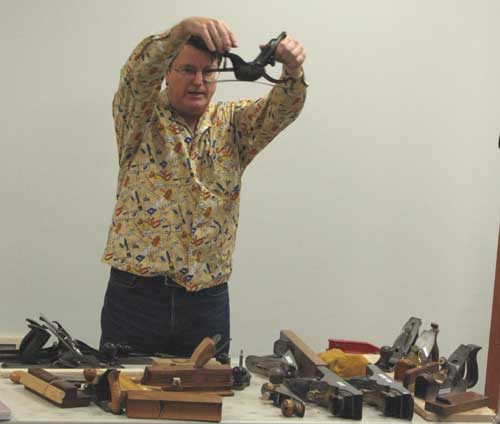
Last meeting
![]()
Bill started our October meeting by announcing that next month will be the annual Box Contest and a show of jigs and fixtures by you the members.
Our Rafflemeister Stan Booker showed the items that will be available as door prizes. He also showed a very large board (18 BF) of Pagoda Wood which is the item in the raffle. $1 per ticket, 6 for $5.
Stan also talked about his ongoing effort to provide hand tools to woodworking schools in Tanzania and other African countries. They have very few or no tools. He and his family have loaded their suitcases and gone there in the past and are planning to do so again. So, he is asking for donations of any non-electric hand tools that you may be able to donate. You can bring them to the next meeting or contact him at 510 522-7879 sbooker07@alamedanet.net.
Fred Reicher announced that he will continue to head up the refreshments function until the end of the year. We will need a new refreshments person next year. Any volunteers?
Frank Taylor said the Industrial Abrasives in PA have very good prices.
Tony Fanning talked about the help required at Sequoia High School wood shop. It has been and on and off relationship with the teacher there. The teacher's wife recently had a baby so this may explain the lack of communication. Frank Taylor and Jamie Buxton have already done a lot of work for the shop. John Blackmore has volunteered to be the coordinator. The teacher would like to meet with some of the members and talk about the jigs and fixtures and tuning some of the machines. If you are interested to volunteer, contact John at johnblackmore@comcast.net or 650 361-1889.
Show and Tell was next.
Bob Hulgan showed a wooden tongue drum he made of Paduak and Red Oak. The design was in the October 2006 WOOD magazine. He found the butt joints hard to make. The slots on top were also hard to make. The jig saw was hard to use so he switched to a scroll saw but the slots were not wide enough so he then used the jig saw to widen them. While not an accomplished singer, Bob did display excellent playing skills. He has started the Hulgan Bongo Drum players.
Mark Bouquet showed us a teak chair he had made several years ago. Inspired by a design of Frank Lloyd Wright, circa 1895, Mark's chair improved upon the original with a padded back cushion and a webbed lattice of elastic straps under the bottom cushion. The chair has 134 mortise and tenon joints. For glue, Mark used an epoxy resin and finished the piece with a wipe on varnish.

Scotty Logan showed the audience two wooden planes he had made at a Woodcraft class. The first, a smoothing plane had a Purpleheart sole. The second, a work in progress, was a rounded bottom plane made of Canary wood. He recommended the book, Wooden Planes by David Finks.
Ken Habeeb brought in a short log of Chinese Elm he had salvaged from the Stanford Wood Lot. Evidently, Stanford University lets people glean wood from piles left after tree pruning and clean up. He said that he saw people there with chain saws. Evidently they are allowed.
Glen Krug showed a small Vera wood turning he had made. He explained that the Vera wood is brown when cut, but then turns a shade of green when exposed to air.
Gene Clark brought in a band sawn Maple jewelry box.
John Blackmore finished his dining room table made from Alaskan Yellow Cedar. He circulated photos and showed the group a stainless steel threaded insert used to hold the base to the tabletop.
Bill then asked guests to introduce themselves. Christine brought an unusual shaped old plane that she bought at a garage sale. Our plane guru Neal later talked about it in his plane presentation. Mark Jones of Morgan Hill heard of us at the Woodcraft show. He likes to make decorative boxes. Just in time for our November box contest, Mark.
The Main Presentation was next.
Two club members, Neal While and Don Naples talked on hand planes and sharpening techniques, respectively.
Neal began the presentation with a short historical perspective on hand planes. Some of the earliest evidence of hand plane use is found on the murals of burial tombs in Ancient Egypt. Neal held up an old wooden hand plane brought in by a guest, Christine. Neal explained this plane was probably made by convict labor in Ohio in the late 1800s.

Next, Neal showed us an old Stanley plane with a flexible metal sole that could be adjusted from concave to convex. The best plane, Neal disclosed, is a sharp plane. And with that, he introduced Don Naples to talk about sharpening.
Don began with a short explanation of plane types:
Stanley 1 through 4 are smoothing bench planes.
Stanley 5 is a Jack plane
Stanley 6 is a Fore plane
Stanley 7 & 8 are Jointers or Trying planes
Typically the blade on the smoothing, jointer and trying planes have corner edges that are rounded slightly to prevent gouging in the wood. The jack and fore planes have a cambered edge to facilitate the easy removal of lots of wood.
Don showed us apiece of highly figured Maple and demonstrated the finish achieved by sanding, planning and scraping. Sanding produced the dullest finish, whereas planning and scraping clearly brought out the beauty of the figured wood. Bubinga, as a harder wood than Maple, acquires a better finish with scraping.
Don's interest in sharpening led him to develop the Lap Sharp Sharpening System, produced and sold by his company, Artistry in Wood. The unique aspect of the Lap Sharp System is that it allows the user to flatten and polish the backside of the blade, be it plane, chisel or other. When the bevel is sharpened on any system, striations from the gritted sharpening material leave a serrated edge. A serrated edge is not optimally sharp. However, flattening and polishing the back of the blade, will remove the serrated edge. Then it becomes a relatively simple task to sharpen and polish the bevel.
Don sharpens all his planes to a 30 degree angle. He explained there are several schools of thought on proper plane blade sharpening angles. A blade with a primary bevel is sharpened at one angle, usually 25 to 30 degrees. Some people prefer to add a secondary bevel, adding 5 degrees, at the tip of the primary bevel. Others may choose to place only a micro bevel on the very edge of the tip. Still others may choose to cut a back bevel on the tip, claiming it improves cutting in figured woods.
Block planes, Don explained always have the blade bevel up, whereas the bench planes always have the blade bevel down.
Some people prefer to sharpen with diamond stone. Diamonds will remove lots of metal, and will cut fast, but leave serrations. The best abrasive material, Don believes, is Aluminum Oxide. Swarf, or abrasive residue becomes a problem, causing clogging of the abrasive medium at grits under 10 micron (2000 grit). He recommends sharpening by lubricating with water. It keeps the abrasive cleaner and the tool steel cooler, minimizing the likelihood of losing temper in the steel. If you use the Scary Sharp method of sharpening, that is using sand paper on a glass plate, use Aluminum Oxide paper, not Silicon Carbide.
When asked about hollow grinding, Don replied that it is easy to feel the sharp edge. But the technique is not appropriate for laminated steel blades, such as the Japanese chisels and planes. A flat edge, he pointed out is stronger, in any tool. He does not recommend using the elliptical jog on water stones because the roller will eventually create a hollow in the stone.
Blade hardness is usually measure in RC from 58 to 64. Japanese steel comes in at 64, Lie Nielsen blades around 63. He likes Ron Hock blades.
Neal then came back again to demonstrate how to use a sharp plane. Neal showed us his shooting board, a fixture designed to produce exact 90 angles. The work piece is held on the board at 90 degrees to the path of the hand plane. The hand plane is passed along the face of the board, cutting the work piece at exactly 90 degrees. Neal cuts 45 degree angles by adding a 45 degree triangle to the fixture.
Neal showed us how to hold the large Stanley 7 or 8 jointer plane to produce a square edge suitable for jointing with another similarly prepared board. He marks the edge with a pencil, showing its high and low edges, then adjusts the tilt of his jointer plane to trim off the high spots. He holds his left hand on the front edge of the plane rather than on the knob in order to achieve better control.
When asked which planes he would recommend to buy, Neal said that both the Lee Valley and Lie Nielsen planes are excellent. Don uses his infill planes, but pointed out that they are hard to find and expensive.
Neal does have classes on how to bring your plane up to shape. There are 6 in the class and you have to bring a plane in whatever shape its in. He has a class on 11/17 which is full but does have a waiting list. The second class is on 1/19 and is open. The classes normally go 10 am-6 pm. The classes are at the Sawdust Shop in Sunnyvale. Contact Neal at nealwhite46@yahoo.com or 408 287-2371.
A motion was introduced that all members should sell their random orbit sanders. It did not pass.
The meeting ended with happy members scurrying home with their door prize loot. Of course, your newsletter editor didn't win nothing!
John Blackmore and Mark Rand